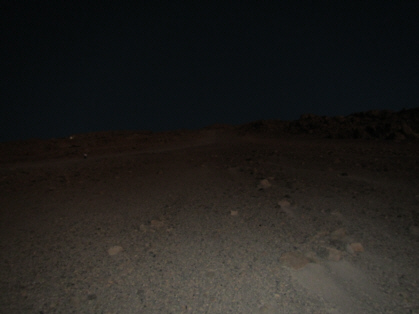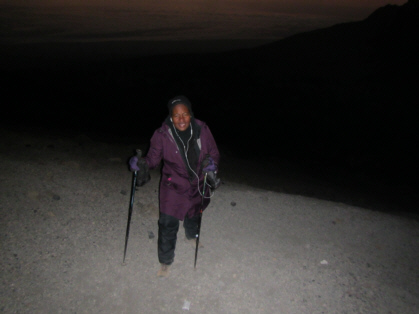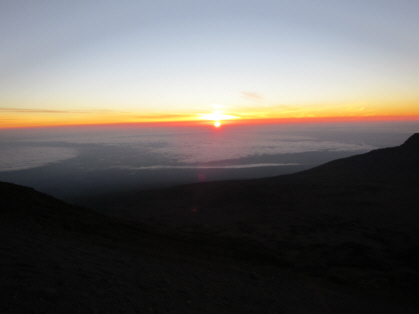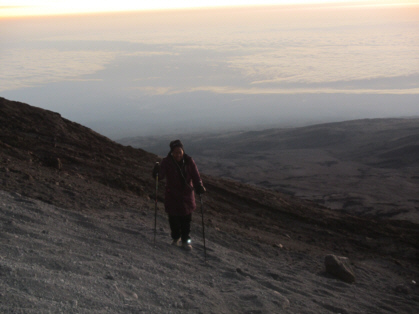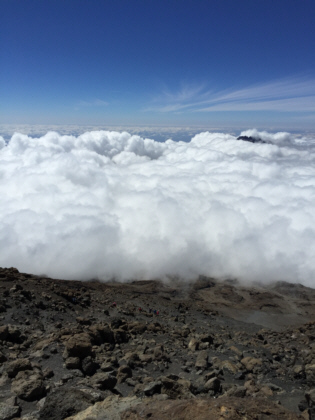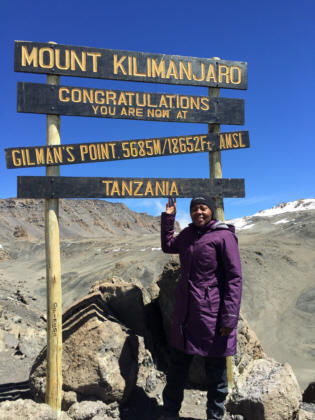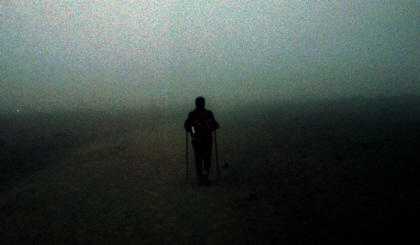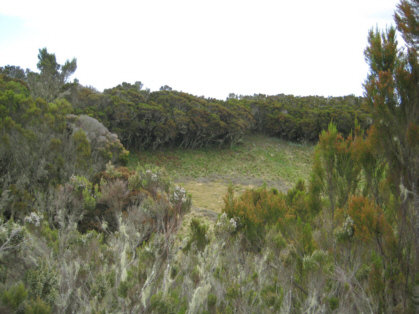Summit Night/Day 5:
From our pre-trip research, we knew that Mt. Kilimanjaro can experience sub-zero temperatures. It was cold on the night of our summit attempt but fortunately not sub-zero – at least not at base camp. Regardless, I was wearing a moisture-wicking shirt, a thick fleece pullover, a wind-breaker, my winter jacket, liner gloves, and ski gloves for my upper layers. My bottom layers consisted of liner socks, wool hiking socks, running tights, Under Armor sweat pants, and ski pants. To protect my head and face from the cold, I wore a knit cap and the hood of my winter jacket. I did not feel cold at all during our climb.
We put our headlamps on and followed our guides into the night. Knowing that Traci and I are slow walkers, our lead guide set an extremely slow pace. Additionally, our guides carried our daypacks containing our water and snacks. The terrain was mostly gravel and sand. This is known as scree. Our lead guide led us in a zig-zag pattern so that we could climb gradually instead of heading straight up the steep slope. I got worried because about a half-hour into our trek, Traci asked us to stop. She then leaned on her walking poles while trying to catch her breath. Traci and I had made an agreement before we started that if she needed to turn back, I would turn back with her. However, if I was the one who needed to turn back, she would continue the climb since reaching the summit of Mt. Kilimanjaro was her bucket list item. Fortunately, after a short rest on a rock, Traci was able to regain her energy.
Summit Night
We continued slowly up the mountain. One of our guides began to sing the Kilimanjaro song in Swahili. Looking up, I could see streams of headlamps of other climbers along the mountainside. Likewise, looking down, I could see the headlamps of people who were just beginning their summit attempt. Then suddenly around three hours into our climb, I got that dreaded empty stomach feeling. Knowing that this was the same feeling I got before I lost my energy on Day 2, I quickly tried to force down a package of sweet & salty trail mix. But, I was too late. My heart began racing. I was struggling to catch my breath. It took every ounce of my strength to move my feet just an inch. I was losing ground to Traci and our lead guide. Our other guide was starting to suggest that I should consider returning to base camp. I ignored him for a while but I could see I was expending a lot of energy and moving nowhere. Finally, the guide gave me the speech about the mountain always being there but I only have one life. He told me that from his experience, a person in my condition needs to get to a lower altitude quickly. At this point, it became like a scene from an old movie. I was telling Traci to go on without me and that I would be okay. Reach your goal! Traci continued her climb with our lead guide while our other guide walked with me back down to Kibo.
I thought that it would be easier for me to walk now that I was descending the mountain but I was feeling just as exhausted as I was when I was trying to ascend. Eventually, the guide walked arm-and-arm with me back down to base camp. I was so fatigued when got there that the guide had to help me take off my layers so that I could get into my sleeping bag. The rest of my time at Kibo was spent napping or sitting at the table with our guide or a porter telling me “Eat. You must try to eat something.” With my appetite pretty much non-existent, the best I could do was gnaw on a piece of dry toast.
Several hours had passed and Traci and our guide had not yet returned. The guide that was with me told me that he had sent a porter up the mountain with some orange juice to give to Traci if he could find her. Finally, around 3 PM, Traci and our guide returned. I was elated when Traci told me that she made it to Gilman’s Point. This means she earned a certificate for summiting Mt. Kilimanjaro. The original estimate for reaching Gilman’s from Kibo was 5 to 7 hours. Traci and I knew it would take longer for us since we are slow walkers. I was floored and proud when Traci told me it took her 11 hours! She decided not to continue to Uhuru Peak which would have earned her a gold certificate. Uhuru is about 1.5 to 2 hours from Gilman’s Point. Knowing that going there and back to Gilman’s could take more than 4 hours, she abandoned that idea. Furthermore, in the daylight, she could see how steep the descent to base camp was going to be. Some other guides in addition to ours offered to help her down the slope. She eagerly took them up on their offer. It took them 4 hours to descend from Gilman’s Point to Kibo. I really admire Traci’s dedication. I was disappointed that I was not able to be at the summit with her.
Views from Mt. Kilimanjaro
Back at Kibo, Traci caught a quick nap and said that it was the best sleep she had had since we started our mountain trek. She only got 30 minutes of sleep before the guides told us we needed to leave Kibo because a large group was on their way. They would need all the rooms. We packed up and began our trek with our guides on the desert path to Horombo. Now that the anxiety of a summit attempt was behind us, Traci and I were more observant of the surreal desert landscapes. If we stood still and were silent, the place was so quiet it was as if we were wearing earplugs.
It took us about 3.5 hours to make it down to Horombo. We needed our headlamps towards the end of the journey. During June it gets dark around 7 PM on the mountain. We had dinner and then went back to our hut to prepare the tip envelopes that we brought with us. Our guide had given us the names of our support team members. This was helpful because we never saw our porters. They worked efficiently behind the scenes. They would stay behind to pack up each camp and then carry heavy loads at a fast pace to the next camp. By the time Traci and I arrived, they would already have our duffle bags delivered and the cook would already have our meal prepared.
Day 6:
The next morning, we handed out tip envelopes to our support team. The support team for Traci and me consisted of two guides, four porters, and a cook. I read at least two sources that indicated each hiker should expect to pay at least $300 in tips. That meant a total of $600 from Traci and me. We ended up dividing $700 in tips amongst our support team. I would have given more if I could at the time. They had done such an awesome job. We experienced some cultural differences when we handed out the envelopes. I was not expecting the team to open the envelopes and start comparing their pay to that of their teammates.
At 9 AM, we started on what we were told would be a 7-hour hike to the park exit. It was along the same path we ascended on Day 2. Traci and I were moving at our usual pole pole pace. Traci is much more timid when descending than ascending so I found myself waiting when I got too far ahead of her and our guides. This was the exact opposite scenario than when we were ascending.
What I found impressive about our guides, besides their patience and stamina, was that every day they conversed with each other (in Swahili) for the duration of our hike. It did not matter if we were trekking for 3 hours or for 7 hours, they were always walking behind Traci and me chatting away. I don't think there is anyone on this earth to whom I could talk to for that many hours every day without running out of things to talk about.
Even though Traci and I were starting to get worn out 4 hours into our hike, Traci asked our guides to take us on the 20-minute detour up a hill to see Maundi Rim Crater. The crater was not as impressive as other scenery we had seen during our journey. It just looked like a large grassy hole in the ground. Nevertheless, we took a picture of it and continued on to Mandara Hut for lunch.
At Mandara, our cook prepared a stew for Traci and me. He said it was popular with the local Chagga People. It reminded me of beef stew but it had bananas in it. It was delicious! Now that we were at a lower altitude, my appetite had returned with a vengeance. I pretty much ate the whole pot by myself. During lunch we met a church group from North Carolina that was in Tanzania to do charity work. This was their day off so they were doing an excursion in which you hike to Mandara for lunch and then return to the park entrance.
After lunch it was time to hit the trail again for the final leg of our 6-day journey. Traci and I were so ready to be off the mountain. Our guides must have been tired of our slow pace so they informed us that they would call a park ranger to give us a ride to the park exit. We still had to walk an hour or so before we got to the ranger’s truck. We were driven the last two miles or so to the park exit. We signed out. Traci received her certificate for making it to Gilman’s Point. It was not long after that that we saw our porters coming down the trail with our duffle bags balanced on their head. The Evans Tours van was waiting to take Traci and me along with our support team back to our hotel in Moshi. It was about an hour drive back to the hotel. I'm surprised the driver was not wearing a nose clip. The nine of us had not showered in six days!
After the Climb
It felt great to finally be off the mountain. Evans Tours dropped Traci and me off back at the Lutheran Uhuru Hotel. We said goodbye to our support team and thanked them again for the outstanding job they did in taking care of Traci and me on the mountain that week.
We got checked in and picked up our other luggage that the hotel had been holding for us while we were off climbing Mt. Kilimanjaro for the last 6 days. We were given the same room we had before our climb. The room which seemed basic when we first arrived in Tanzania now felt like a 5-star resort after a week of sleeping in a sleeping bag. Most of all, it felt great to finally take a shower instead of using baby wipes.
Traci and I headed to dinner. We got such a surprise when we walked into the dining hall – everyone started applauding! There were our comrades with whom we started our Mt. Kilimanjaro trek. They had done the 5-day trek so they returned to the hotel a day earlier than Traci and me. We were so happy to see them. Over dinner we discussed the triumphs and miseries of our Mt. Kilimanjaro experiences. Some of the 5-day climbers did the bike race the day after they returned from the mountain. They said it was hilly and that the bikes they were given were not in the best condition. We also met new people who were part of our group but did not sign up for the Mt. Kilimanjaro climb option. They were there for various combinations of the bike race, the marathon, and the safari. As a result, they arrived in Tanzania while the rest of us were on the mountain.
Back in our room, Traci and I began the task of reorganizing our luggage for the rest of the trip. We decided that the duffle bags we used on the mountain would become our laundry bags. All of the clothing we wore on Mt. Kilimanjaro was so filthy.
The next morning was rough. Maybe the adrenaline of our mountain trek kept our minds off of any pain but now that we were no longer on the mountain, our bodies were screaming for relief. We had knee pain, stiffness, and numb toes. The skin around our mouth and nose was chapped and peeling. Traci’s face and bottom lip was swollen. Fortunately, Traci’s swelling went away within an hour. This pattern continued for the next two mornings. Furthermore, both of our lips had darkened – Traci’s much more than mine. We were not sure if the lip darkening was a result of the mountain or the malaria pills we were taking. We were somewhat comforted after talking to others in our group who had climbed the mountain. Many of them had experienced some of the same list of symptoms.
That morning, I began to reflect on our experience. I felt a little disappointed about having to abandon my summit attempt but not as bad as I would feel about the situation in the coming weeks. Even though climbing Mt. Kilimanjaro was not on my bucket list I had put a lot of effort into the trek. I knew going in that the Marangu Route that we traveled has a less than 50% success rate due to the short time span for acclimatization; however, I was hoping that adding the 6th day would had gotten both of us to the summit. I went through a period of searching for answers when I got home. Was I not fit enough to make it to the summit? Should I have been forcing myself to eat every hour during the hike in an effort to avoid that hunger feeling I got just before my energy level plummeted? Should I have tried taking a break before giving into the guides’ advice to return to Kibo? Had my body just not adjusted to the high altitude? I will never know the answers to these questions. One thing I do know is that I have no desire to try the climb again any time soon. Continue to Moshi...
Mt. Kilimanjaro Day 1 | Mt. Kilimanjaro Day 2 | Mt. Kilimanjaro Days 3 & 4 | Mt. Kilimanjaro Days 5 & 6 | next
~~~~~~~~~~~~
Intro | Mt. Kilimanjaro Climb | Moshi | Safari | Ethiopia
Preparing For Our African Adventure
Magnet Purchased on this Trip: (click to enlarge)
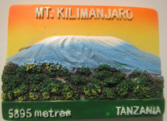 Entire fridge magnet collection...
[Back to the Main Page]
Entire fridge magnet collection...
[Back to the Main Page]
